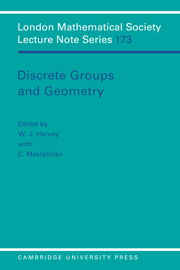Book contents
- Frontmatter
- Contents
- Preface
- Symmetries of modular surfaces
- Lifting group actions to covering spaces
- A combinatorial approach to the symmetries of M and M–l Riemann surfaces
- Inequalities for Pell equations and Fuchsian groups
- The Euler characteristic of graph products and of Coxeter groups
- Infinite families of automorphism groups of Riemann surfaces
- Planar hyperelliptic Klein surfaces and fundamental regions of NEC groups
- An example of an infinite group
- Moduli of Riemann surfaces with symmetry
- Modular groups – geometry and physics
- On automorphisms of free products
- The growth series of the Gieseking group
- Exceptional representations of PSL2(q) of monodromy genus zero
- On the rank of NEC groups
- The geometry of bending quasi-Fuchsian groups
- Farey series and sums of continued fractions
- Commensurability classes of two-generator Fuchsian groups
- Limit points via Schottky pairings
- Diagonalizing Eisenstein series III
- Some remarks on 2-generator hyperbolic 3-manifolds
- Uniformization, graded Riemann surfaces and supersymmetry
- Generating sets for finite groups
- Group actions on trees with and without fixed points
Commensurability classes of two-generator Fuchsian groups
Published online by Cambridge University Press: 10 December 2009
- Frontmatter
- Contents
- Preface
- Symmetries of modular surfaces
- Lifting group actions to covering spaces
- A combinatorial approach to the symmetries of M and M–l Riemann surfaces
- Inequalities for Pell equations and Fuchsian groups
- The Euler characteristic of graph products and of Coxeter groups
- Infinite families of automorphism groups of Riemann surfaces
- Planar hyperelliptic Klein surfaces and fundamental regions of NEC groups
- An example of an infinite group
- Moduli of Riemann surfaces with symmetry
- Modular groups – geometry and physics
- On automorphisms of free products
- The growth series of the Gieseking group
- Exceptional representations of PSL2(q) of monodromy genus zero
- On the rank of NEC groups
- The geometry of bending quasi-Fuchsian groups
- Farey series and sums of continued fractions
- Commensurability classes of two-generator Fuchsian groups
- Limit points via Schottky pairings
- Diagonalizing Eisenstein series III
- Some remarks on 2-generator hyperbolic 3-manifolds
- Uniformization, graded Riemann surfaces and supersymmetry
- Generating sets for finite groups
- Group actions on trees with and without fixed points
Summary
Introduction
A Fuchsian group is a discrete subgroup of PSL2(R) and two such groups Γ1,Γ2 are commensurable if and only if the intersection Γ1 ∩ Γ2 is of finite index in both Γ1 and Γ2. In this paper we determine when two two-generator Fuchsian groups of finite covolume are commensurable and in addition, the relationship between two such groups, by obtaining part of the lattice of the commensurability class which contains one representative from each conjugacy class, in PGL2(R), of two-generator groups. By the result of Margulis (see e.g. [Z]) that a non-arithmetic commensurability class contains a unique maximal member, the non-arithmetic cases reduce to a compilation of earlier results on determining which two-generator Fuchsian groups occur as subgroups of finite index in other two-generator Fuchsian groups [Sc], [S2], [R]. For the arithmetic cases, all two-generator arithmetic Fuchsian groups have been determined [T2], [T4], [MR] and one can immediately read off when two such groups are commensurable from the structure of the corresponding quaternion algebra (see e.g. [T3]). The relationship between such groups is more difficult to determine and we utilise structure theorems for arithmetic Fuchsian groups [B], [V]. The relationship between arithmetic triangle groups was determined in [T3].
- Type
- Chapter
- Information
- Discrete Groups and Geometry , pp. 171 - 189Publisher: Cambridge University PressPrint publication year: 1992
- 4
- Cited by



